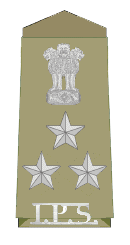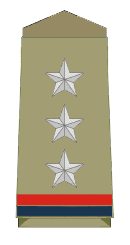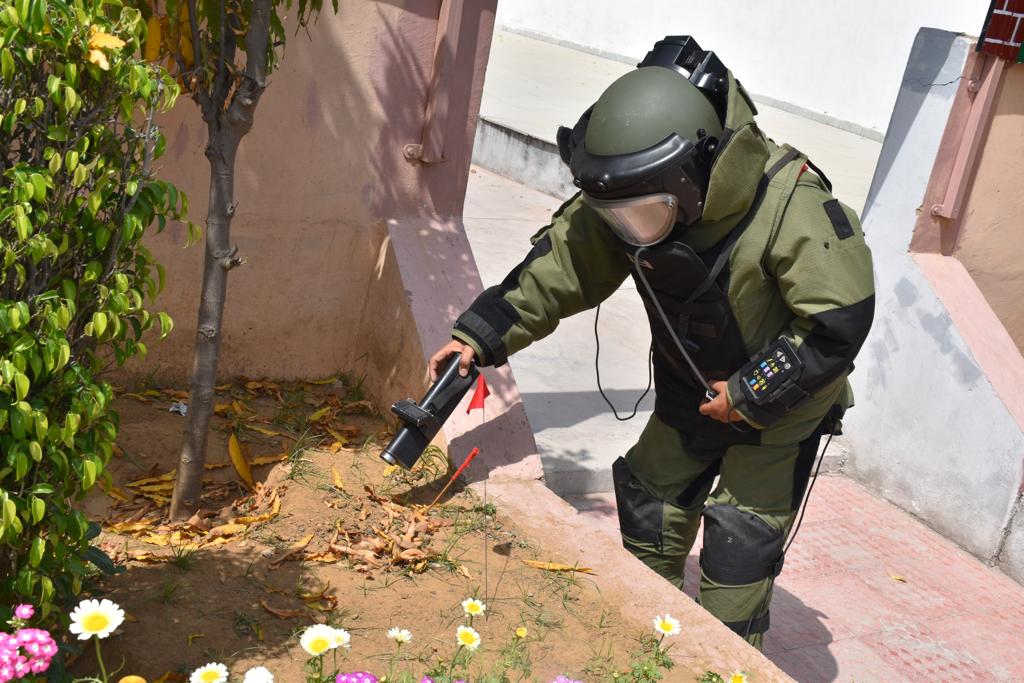|
Gajender Singh Bisht
Gajender Singh Bisht (1 July 1972 – 28 November 2008) was an National Security Guards, NSG commando and Havildar (Sergeant) who was killed during the 2008 Mumbai attacks. His act of bravery was honoured with the Ashoka Chakra Award, Ashoka Chakra award by the President (government title), President of India on 26 January 2009, India's Republic Day (India), Republic Day. Childhood Hailing from Ganeshpur in Dehradun, Uttarakhand, young Gajender Singh studied at the Janata Inter College in Naya Gaon. He was remembered by his teachers as a disciplined student who participated in every event organised in the school, sports or cultural activities. He had a particular interest in boxing. Operation Black Tornado Gajender Singh was a member of the National Security Guard’s 51 Special Action Group. He was part of the team of NSG commandos who were fast-roping, fast-roped onto the roof of Nariman House in an operation to neutralize the terrorists inside who were holding at least s ... [...More Info...] [...Related Items...] OR: [Wikipedia] [Google] [Baidu] |
Havildar
Havildar or havaldar ( Hindustani: or (Devanagari), (Perso-Arabic)) is a rank in the Indian, Pakistani and Nepalese armies, equivalent to sergeant. It is not used in cavalry units, where the equivalent is daffadar. Like a British sergeant, a havildar wears three rank chevrons. History "Havildar" is a Persian word in origin and means "person in charge", or more loosely "chief", from the Arabic ("charge", "responsibility") and the Persian (dâr, "holder"). Historically, a havildar was a senior commander, being in charge of a fort during the times of the Mughal Empire. It was used as the equivalent of a sergeant in the British Raj, which has led to its current usage. Appointments Indian Army Havildars could be further appointed to positions of higher authority. The appointments of company quartermaster havildar and company havildar major existed in the British Indian Army. Historically, the two senior-most havildars of a company became the CQMH and the CHM. However, these we ... [...More Info...] [...Related Items...] OR: [Wikipedia] [Google] [Baidu] |
Sergeant
Sergeant (abbreviated to Sgt. and capitalized when used as a named person's title) is a rank in many uniformed organizations, principally military and policing forces. The alternative spelling, ''serjeant'', is used in The Rifles and other units that draw their heritage from the British light infantry. Its origin is the Latin , 'one who serves', through the French term . The term ''sergeant'' refers to a non-commissioned officer placed above the rank of a corporal, and a police officer immediately below a lieutenant in the US, and below an inspector in the UK. In most armies, the rank of sergeant corresponds to command of a squad (or section). In Commonwealth armies, it is a more senior rank, corresponding roughly to a platoon second-in-command. In the United States Army, sergeant is a more junior rank corresponding to a squad- (12 person) or platoon- (36 person) leader. More senior non-commissioned ranks are often variations on sergeant, for example staff sergeant, gunn ... [...More Info...] [...Related Items...] OR: [Wikipedia] [Google] [Baidu] |
Deaths By Firearm In India
Death is the irreversible cessation of all biological functions that sustain an organism. For organisms with a brain, death can also be defined as the irreversible cessation of functioning of the whole brain, including brainstem, and brain death is sometimes used as a legal definition of death. The remains of a former organism normally begin to decompose shortly after death. Death is an inevitable process that eventually occurs in almost all organisms. Death is generally applied to whole organisms; the similar process seen in individual components of an organism, such as cells or tissues, is necrosis. Something that is not considered an organism, such as a virus, can be physically destroyed but is not said to die. As of the early 21st century, over 150,000 humans die each day, with ageing being by far the most common cause of death. Many cultures and religions have the idea of an afterlife, and also may hold the idea of judgement of good and bad deeds in one's life (heaven, ... [...More Info...] [...Related Items...] OR: [Wikipedia] [Google] [Baidu] |
2008 Deaths
This is a list of deaths of notable people, organised by year. New deaths articles are added to their respective month (e.g., Deaths in ) and then linked here. 2022 2021 2020 2019 2018 2017 2016 2015 2014 2013 2012 2011 2010 2009 2008 2007 2006 2005 2004 2003 2002 2001 2000 1999 1998 1997 1996 1995 1994 1993 1992 1991 1990 1989 1988 1987 See also * Lists of deaths by day The following pages, corresponding to the Gregorian calendar, list the historical events, births, deaths, and holidays and observances of the specified day of the year: Footnotes See also * Leap year * List of calendars * List of non-standard ... * Deaths by year {{DEFAULTSORT:deaths by year ... [...More Info...] [...Related Items...] OR: [Wikipedia] [Google] [Baidu] |
Tukaram Omble
Tukaram Omble Ashoka Chakra (military decoration), AC ( 1954 – 27 November 2008) was an Indian police officer and a former member of Indian army who served as an assistant sub-inspector (ASI) of the Mumbai Police. He was killed in action during the 2008 Mumbai attacks, at Girgaum Chowpatty in Mumbai. The Indian government posthumously honoured Omble on 26 January 2009 with the Ashoka Chakra Award, Ashoka Chakra, the country's highest peacetime military award. Biography Omble joined the Mumbai police as a constable in 1991 after retiring from the Indian Army's Signal Corps as a Naik (military rank), naik. He was an ASI in the Mumbai Police. On 26 November he and his team were guarding a checkpoint when they were approached by two pakistani terrorist in a hijacked vehicle. After an initial shootout, one of the terrorists died inside the vehicle. The other terrorist, Ajmal Kasab, exited the vehicle and feigned surrender. As an unarmed Omble approached him, Kasab got up and ope ... [...More Info...] [...Related Items...] OR: [Wikipedia] [Google] [Baidu] |
Ashok Kamte
Ashok Kamte AC (23 February 1965 – 26 November 2008) was an Indian police officer, serving as the Additional Commissioner of the Mumbai Police supervising the Eastern region. He was killed in action during the 2008 Mumbai attacks. He was posthumously given the Ashoka Chakra on 26 January 2009. Personal background The son of Lieutenant-Colonel Marutirao Narayanrao Kamte (August 22, 1929 – 13 January 2014) and his wife Kalpana, Ashok Kamte was born on 23 February 1965 in a Marathi family with a long tradition of police service. His great-grandfather, Rao Bahadur Marutirao Kamte KPM IPM, had served in the Indian Imperial Police from 1895 to 1923, while his grandfather Narayanrao also joined the Imperial Police in 1923, eventually serving as the first Indian Inspector-General (Director-General) of the Maharashtra Police from 1947 to 1955. Kamte's schooling consisted of The Rajkumar College, Rajkot, and then the Kodaikanal International School for five years. He was an inte ... [...More Info...] [...Related Items...] OR: [Wikipedia] [Google] [Baidu] |
Vijay Salaskar
Vijay Salaskar, AC (24 February 1957 – 26 November 2008) was an Indian police inspector and encounter specialist with the Mumbai police. He was widely credited with killing 75–80 criminals in encounters – most of these were members of the Arun Gawli gang. Salaskar was killed while fighting terrorists in the November 2008 Mumbai attacks. Captured terrorist Ajmal Amir Kasab claimed responsibility for the killing. Before his death Salaskar was head of the Anti-Extortion Cell, Mumbai. Retrieved 27 November 2008 His patriotism and bravery was honoured with the Ashoka Chakra on 26 January 2009. Early life and his career He joined Bombay Police (now Mumbai Police) as a sub inspector in 1983. ''India Today'' reports Salaskar's first lethal encounter occurred during his first year of appointment, when he shot dead Raja Shahabuddin, known to police on several counts. Salaskar, who was reportedly sidelined for the last two years for unearthing the gutka-underworld nexus, was re ... [...More Info...] [...Related Items...] OR: [Wikipedia] [Google] [Baidu] |
Sandeep Unnikrishnan
Sandeep Unnikrishnan, AC (15 March 1977 – 28 November 2008) was an Indian Army officer, who was serving in the 51 Special Action Group of the National Security Guards on deputation. He was Martyred in action during the November 2008 Mumbai attacks. He was consequently awarded the Ashoka Chakra, India's highest peacetime gallantry award, on 26 January 2009. Early and personal life Sandeep Unnikrishnan came from a Malayali family residing in Bangalore, where they had moved from Kozhikode, Kerala. He was the only son of retired ISRO officer K. Unnikrishnan and Dhanalakshmi Unnikrishnan. Unnikrishnan attended The Frank Anthony Public School, Bangalore, graduating in 1995 in the ISC Science stream. He wanted to join the armed forces from childhood. He was married to Neha. Military career Unnikrishnan joined the National Defence Academy (India) (NDA), Pune, Maharashtra in 1995. He was a part of the Oscar Squadron (No. 4 Battalion) and a graduate of the 94th Course NDA. He held ... [...More Info...] [...Related Items...] OR: [Wikipedia] [Google] [Baidu] |
Hemant Karkare
Hemant Karkare AC () (12 December 1954 – 27 November 2008) was the chief of the Mumbai Anti-Terrorist Squad (ATS). He was killed in action during the 2008 Mumbai attacks. In 2009, he was posthumously given the Ashoka Chakra, India's highest peacetime gallantry decoration. Karkare succeeded K. P. Raghuvanshi as the Chief of ATS in January 2008 and was eventually succeeded by Raghuvanshi after he was shot dead on 26 November 2008. He was credited with solving the serial bombing cases in Thane, Vashi and Panvel, and led the investigation of the 2008 Malegaon blasts. Early life Hemant Karkare was born in a Maharashtrian Brahmin family. Education and career Karkare did his primary schooling from Chittranjan Das Municipal Primary School, Wardha and then received his middle school and high school education from New English High School,Nagpur. He obtained a Bachelor of Engineering degree in Mechanical Engineering from Visvesvaraya National Institute of Technology, Nagpur in 1975. ... [...More Info...] [...Related Items...] OR: [Wikipedia] [Google] [Baidu] |
Nariman House
The Nariman House, designated as a Chabad house ( he, בית חב"ד '), is a five-storey landmark in the Colaba area of South Mumbai, Maharashtra, India. The building was home to a Chabad house, a Jewish outreach centre run by Gavriel and Rivka Holtzberg, who had owned the building since around 2006. The centre had an educational center, a synagogue, offered drug prevention services, and a hostel. The building was attacked during the November 2008 Mumbai attacks and six of its occupants, including Holtzberg and his wife, who was six months pregnant, were killed. Their two-year-old son Moshe survived the attack after being rescued by his Indian nanny, Sandra Samuel, and Zakir Hussain. Chabad House The Chabad house, located at 5 Hormusji Street, Colaba, is one of eight synagogues in MumbaiJTA and ha ... [...More Info...] [...Related Items...] OR: [Wikipedia] [Google] [Baidu] |
Fast-roping
Fast-roping is a technique for descending a thick rope, allowing troops to deploy from a helicopter in places where the aircraft cannot touch down. The person holds onto the rope with gloved hands (with or without using their feet) and slides down it. Several people can slide down the same rope simultaneously, provided that there is a gap of about between them, so that each one has time to get out of the way when they reach the ground. Fast roping is quicker than abseiling (rappelling), although more dangerous, particularly if the person is carrying a heavy load, because the rope is not attached to them with a descender. The technique is particularly useful for naval infantry, who can use it to board ships at sea. History The technique was first developed by the UK with British rope manufacturer Marlow Ropes, and first used in combat during the Falklands War. The original rope was made of thick nylon that could be used in a manner akin to a fireman's pole. The special rope ... [...More Info...] [...Related Items...] OR: [Wikipedia] [Google] [Baidu] |
National Security Guard
The National Security Guard (NSG), commonly known as Black Cats, is a counter-terrorism unit of India under the Ministry of Home Affairs. It was founded on 16 October 1984, following Operation Blue Star, for combating terrorist activities and protect states against internal disturbances. Formalised in the Parliament of India under the National Security Guard Act, 1986. It is one of the seven Central Armed police forces of India. Mission The National Security Guard states its mission as: "Train, equip and keep in readiness a special force capable of swiftly and effectively combating terrorism to live up to its motto ''Sarvatra Sarvottam Suraksha''" The NSG is a 'Federal Contingency Deployment Force' to tackle all facets of terrorism in the country. As a specialised counter-terrorism force, it is intended to be used "only in exceptional situations" and is not meant to take over the "functions of the State Police Forces or other Para Military Forces". Yet, over the years its rol ... [...More Info...] [...Related Items...] OR: [Wikipedia] [Google] [Baidu] |







